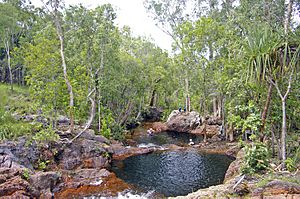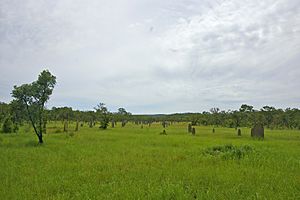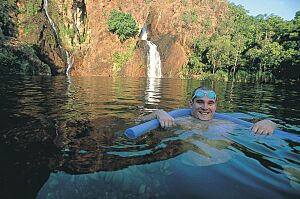Litchfield National Park facts for kids
Quick facts for kids Litchfield National ParkNorthern Territory |
|
|---|---|
|
IUCN Category II (National Park)
|
|
| Nearest town or city | Adelaide River |
| Established | 29 July 1991 |
| Area | 1,458.47 km2 (563.1 sq mi) |
| Visitation | 329,600 (in 2017) |
| Managing authorities | Parks and Wildlife Commission of the Northern Territory |
| Website | Litchfield National Park |
| See also | Protected areas of the Northern Territory |
Litchfield National Park is a fantastic natural area covering about 1500 square kilometers. It's located near the town of Batchelor, which is about 100 kilometers southwest of Darwin in Australia's Northern Territory. Every year, over 260,000 people visit this amazing park!
The park became a national park in 1986. It's named after Frederick Henry Litchfield, an early explorer who traveled through parts of the Northern Territory in 1864.
Contents
History of Litchfield National Park
Ancient Times
Aboriginal people have lived in this area for thousands of years. It's a very important place for the Kungarakan and Marranunggu peoples. They believe their ancestral spirits are still present in the land, shaping its landscapes, plants, and animals.
European Exploration and Settlement
The park was named after Frederick Henry Litchfield, who was part of an expedition from South Australia in 1864. This group was the first European expedition to explore the Top End of Australia by land. They hoped to set up a new settlement.
In September 1865, Litchfield led a small group to explore the Daly River area. He wrote in his diary about the beautiful plains, great grass, and plenty of water, calling it a "fine country for stock."
Mining and Farming
Later, people discovered copper and tin in the area. This led to small mining operations. Farmers also started raising cattle in the 1870s, even though conditions were tough with heavy rain and many insects.
The first tin mine started at Mt Tolmer in 1888. Another tin mine, Bamboo Creek, began in 1906. Miners often found high-quality tin right on the surface or in old riverbeds. They would simply bag it up and sell it. These small mines operated for about 30 years.
In 1924, the Sargent family built a small farm near Tolmer Falls. They later built Blyth Homestead in 1928 as an outstation for their cattle. This homestead was made from cypress pine and corrugated iron. The family grew their own food and had many cattle because of the nearby water. After 40 years, they sold the farm. The old homestead still stands today, showing how hard life was for early farmers.
Logging of trees like paperbark and cypress began in 1948. Aboriginal people helped with this work.
In 1949, uranium was found near the park's eastern edge. This led to the Rum Jungle mine, which was Australia's first working uranium mine. It was a big part of the Northern Territory's economy, selling uranium to the United Kingdom. The mine closed in 1971.
Before it became a national park, the area was part of large cattle stations. In 1985, the land was set aside for conservation.
Plants of Litchfield National Park
The park's sandstone plateau has many types of trees, like Darwin woolybutt and Darwin stringybark. You'll also find banksias and grevilleas here.
Along the bottom of the cliffs and in deep gorges, you can find special pockets of rainforest. These areas are important because they are large and mostly untouched. Here, you might see lilies, orchids, Pandanus plants, and paperbark trees.
Animals of Litchfield National Park
Litchfield National Park is home to many amazing animals. You might spot antilopine kangaroos, agile wallabys, sugar gliders, and dingos. The caves near Tolmer Falls are a special home for rare orange leaf-nosed bats and ghost bats.
Hundreds of bird species live in the park. You'll often see Black kites flying overhead. Near the waterfalls, look for colorful birds like the yellow oriole, figbird, and rainbow bee-eater.
In the Wangi Falls area, you might find a small marsupial mouse called the northern dibbler, a frog called the pealing chirper, and even a fish that can shoot water, the primitive archerfish.
The popular waterfalls attract birds and reptiles like monitors. You might also see Frill-necked lizards, though they hide more in the cooler months. Be aware that the Finniss River area has large saltwater crocodiles.
Magnetic Termite Mounds
One of the park's most famous sights is the magnetic termite mounds. These tall, wedge-shaped mounds are built by thousands of termites. They are always aligned in a north-south direction! This special alignment helps the mounds stay cool inside, acting like a natural air conditioner for the termites. The termites live in these mounds to stay above the water during seasonal floods.
Special Places to See
Bamboo Creek Tin Mine
The Bamboo Creek tin mine shows how mining was done a long time ago, without big machines. It's a great example of the small, hard-working mines from the 1800s and early 1900s. You can still see the old mine workings, the tin processing mill, and other remains from the miners' lives. It reminds us of the tough conditions these early miners faced.
Blyth Homestead
Blyth Homestead is an important historical site. It's a single room building made of cypress pine and corrugated iron, with verandahs all around. It was built in 1928 as an outstation for a cattle farm. The family who lived here had to be very self-sufficient, growing their own food and even doing some tin mining to earn extra money. The homestead shows how simple and tough life was for pioneers in remote areas.
Greenant Creek Sacred Site
The area of Greenant Creek below the Tjaetaba Falls is a registered Aboriginal sacred site. To respect its cultural importance, swimming or entering the water in this specific area is not allowed. Please follow all signs.
Visiting Litchfield National Park
Over a quarter of a million people visit Litchfield National Park each year. It's less than two hours' drive from Darwin, making it an easy day trip or weekend adventure. You can get there by a sealed road through Batchelor or a partly unsealed road off Cox Peninsula Road.
Park Attractions
Most of the park's main attractions are easy to reach by regular car on sealed roads. However, some more remote spots need a four-wheel drive vehicle.
Florence Falls
Florence Falls is a beautiful waterfall with two drops, leading into a popular swimming hole. It's a great spot to cool off!
Buley Rockhole
At Buley Rockhole, you'll find a series of natural pools that cascade into each other. It's like a natural spa!
Wangi Falls
Wangi Falls is probably the most popular spot in Litchfield. It's easy to get to and usually open all year. Sometimes, after heavy rain, the water levels are too high for swimming.
Tolmer Falls
Tolmer Falls is a stunning waterfall that drops over two high cliffs into a deep pool. The caves at the bottom are home to rare ghost bats and orange horseshoe bats.
Tjaetaba Falls
Tjaetaba Falls is a smaller waterfall along Greenant Creek. Remember, the area below these falls is an Aboriginal sacred site, so swimming is only allowed above the falls.
Tjaynera Falls (Sandy Creek)
After a moderate 3.5-kilometer walk, you can reach the peaceful plunge pool beneath Tjaynera Falls. It's usually less crowded here.
Surprise Creek Falls
These falls are open for swimming and offer another lovely spot to relax.
Magnetic Termite Mounds
Don't miss the unique magnetic termite mounds! These amazing structures are built by termites to control the temperature inside their homes.
Bushwalks and Hiking
Litchfield National Park has many walking tracks for all levels. If you plan to walk overnight, it's a good idea to register your trip. You must camp in special campgrounds.
Tabletop Track
The Tabletop Track is a long 39-kilometer walk through Litchfield National Park. You'll see trickling creeks, waterfalls, clear pools, and rainforests. Keep an eye out for local wildlife like wallabies, possums, and flying foxes!
Florence Creek Walk
This 22-kilometer walk is part of the Tabletop Track. It takes you to Greenant Creek, through cool rainforests where you might spot kingfishers, honey-eaters, and pigeons. This walk is considered difficult and usually takes about two days.
Greenant Creek Walk
This 8.5-kilometer walk, also part of the Tabletop Track, goes from Greenant Creek to Wangi Falls. The creeks here always have water, so there's lots of plant and animal life. Look for Carpentaria palms, fig trees, and weeping paperbark trees. On the ground, you might see geckos, lizards, and frogs.
Wangi Falls Walk
This two-day walk, another part of the Tabletop Track, runs from Wangi Falls to Walker Creek. The rocky landscape is a great home for northern quolls, wallabies, frogs, and lizards. You'll also see many birds, like colorful red-winged parrots and kingfishers.
Walker Creek Walk
This is the final part of the Tabletop Track, taking you from Walker Creek to Florence Falls. You might spot wallabies and possums, or hear the calls of various birds living in the forest.
The Lost City
These amazing freestanding sandstone blocks and pillars look like the ruins of an ancient city! It's one of the best short walks in the park, but you need a four-wheel drive to get there.
Where to Stay
There are several camping spots inside Litchfield National Park, but you'll need to pay a fee. You can camp at:
- Wangi Falls
- Buley Rockhole
- Florence Falls
- Tjaynera Falls (Sandy Creek)
- Walker Creek
- Surprise Creek Falls
- Florence Falls (downstream)
If you prefer not to camp, there are also places to stay outside the park:
- Litchfield Tourist & Van Park
- Wangi Tourist Park
- Banyan Tree Caravan Park
- Batchelor Resort Carravillage
- Batchelor Butterfly & Bird Farm
- Historic Retreat
- Rum Jungle Bungalows
Park Management
Since 2007, the land of Litchfield National Park has also been officially named a locality called Litchfield Park. In 2016, about 44 people lived within its boundaries.
Images for kids










